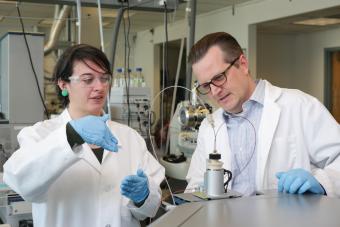Colorado School of Mines launches interdisciplinary research initiative to tackle “forever chemicals”
PFAS@Mines will focus on development of treatment strategies for most challenging PFAS sites, improved methods to characterize human exposure

Researchers at Mines — including University Distinguished Professor Chris Higgins, right — have been working on all aspects of the PFAS problem for many years, taking an interdisciplinary and solution-focused approach to the chemicals.
Colorado School of Mines is standing up a broad-based research initiative to advance scientific understanding of per- and polyfluoroalkyl substances, or PFASs, and develop practical engineering solutions to address these so-called “forever chemicals,” one of the largest-scale environmental and public health challenges facing the U.S. today.
Researchers at Mines have been working on all aspects of the PFAS problem for many years, from fundamental science and how the substances move once they've contaminated water and soil to human exposure routes to environmental remediation and destruction, taking an interdisciplinary and solution-focused approach to the chemicals.
The PFAS@Mines initiative will bring together all PFAS researchers at Mines, from multiple departments and disciplines, to focus the university’s experience and expertise on two core challenges: the development of treatment strategies for the most challenging PFAS-contaminated sites, and the creation of improved tools for assessing all sites, known and emerging, that have been impacted by PFAS. Fundamental research and improved methods and approaches to characterize human exposure to PFAS will also be included.
Initial funding for PFAS@Mines comes from a $2.9 million grant from the U.S. Army Corps of Engineers and is part of an established partnership with the Engineer Research and Development Center (ERDC). PFAS contamination is a growing challenge for the U.S. Department of Defense – hundreds of DoD installations around the nation have groundwater with PFAS levels well above both existing and proposed federal limits, due to the extensive use of firefighting foams, called Aqueous Film Forming Foam (AFFF), containing these substances.
“After climate change, PFAS poses one of the biggest challenges for a generation of environmental scientists and engineers,” said Christopher Higgins, University Distinguished Professor of Civil and Environmental Engineering and lead investigator of the new initiative. “Addressing this nationwide challenge, though, is currently hamstrung by critical barriers and knowledge gaps – gaps that PFAS@Mines will help bridge by adopting an interdisciplinary, solutions-based approach.”
PFAS have been widely used for decades in firefighting foams and household products such as non-stick pans, waterproof clothing, pizza boxes, cosmetics and more. The same properties that make them useful in those applications, however, also keep them from breaking down when they enter the environment, and a growing body of research shows that human exposure to PFAS can cause cancer and developmental, endocrine, renal and metabolic problems.
The U.S. Environmental Protection Agency recently proposed the first federal limits in drinking water for two PFAS, called PFOA and PFOS – at 4 parts per trillion, the lowest level that can be reliably measured.
At Mines, researchers have been involved in the issue on a local and national level. Since 2016, Mines has partnered with the Colorado Department of Public Health and Environment to measure and evaluate human exposures to PFAS, particularly in impacted communities south of Colorado Springs. From measuring PFAS in drinking water and blood to assisting water utilities in identifying optimal treatment technologies, researchers at Mines have been extensively engaged in the local communities. Much of the work near Colorado Springs has been done in collaboration with the University of Colorado Anschutz Medical Campus, and this work has also extended to communities as far away as North Carolina and Michigan.
Frequently funded by the U.S. Department of Defense through the Strategic Environmental Research and Development Program (SERDP) and the Environmental Security Technology Certification Program (ESTCP), Mines has also been working on DoD PFAS issues related to transport and treatment of AFFF-impacted soils and water for more than a decade. Current projects include efforts to better clean firetrucks that have used PFAS-based AFFF, identifying PFAS sources through chemical forensics, optimizing PFAS treatment trains, and assessing the leaching of PFAS out of impacted concrete.
In addition, a group of Mines researchers led by Timothy Strathmann, professor of civil and environmental engineering, has developed one of the most promising solutions for the destruction of PFAS. Hydrothermal alkaline treatment, or HALT, has been proven in scientific studies to completely destroy all types of PFAS, and was recently patented and licensed to a cleantech startup interested in scaling up the Mines technology for commercial use.
“Colorado School of Mines faculty researchers are go-to experts for all aspects of the PFAS crisis – from assessing contamination to water treatment, PFAS destruction and site remediation,” said Dr. Walter Copan, Vice President for Research and Technology Transfer at Mines. “PFAS@Mines represents the critical translation of interdisciplinary science and engineering into real-world solutions, which is the hallmark of impact-driven research at Colorado School of Mines.”
At the outset, PFAS@Mines will focus on four interdisciplinary efforts aimed at the development of more cost-effective and sustainable technologies for remediating PFAS-contaminated water and soil, as well as better tools for assessing and predicting the impacts and risk of contaminated sites across diverse hydrogeologic and biogeochemical conditions:
- Development of remediation and treatment strategies for difficult-to-treat environments, such as soils and wastewater
- Evaluation of the fate and transport of PFAS associated with AFFF-impacted sites
- Investigation of PFAS interactions with biological systems
- Modeling of PFAS behavior at the molecular scale
“With PFAS, nature doesn’t know how to make them, so nature also doesn’t know how to break them,” said Shubham Vyas, associate professor of chemistry. “Fundamental research is the key to understanding how to break down these chemicals. PFAS@Mines will help accelerate important fundamental research – work that, when combined with the applied engineering, will inform how to capture and break down PFAS more effectively and efficiently.”
Faculty from Civil and Environmental Engineering, Chemistry, and Geology and Geological Engineering departments will form the core research group. For more information about PFAS@Mines, visit pfas.mines.edu.




